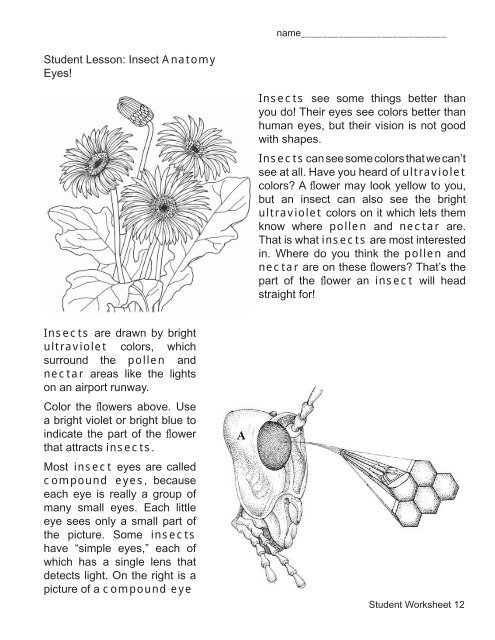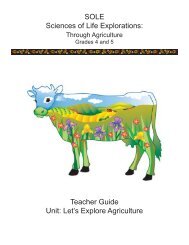Insect Anatomy - Agriculture in the Classroom
Insect Anatomy - Agriculture in the Classroom
Insect Anatomy - Agriculture in the Classroom
You also want an ePaper? Increase the reach of your titles
YUMPU automatically turns print PDFs into web optimized ePapers that Google loves.
name___________________________<br />
Student Lesson: <strong>Insect</strong> <strong>Anatomy</strong><br />
Eyes!<br />
<strong>Insect</strong>s see some th<strong>in</strong>gs better than<br />
you do! Their eyes see colors better than<br />
human eyes, but <strong>the</strong>ir vision is not good<br />
with shapes.<br />
<strong>Insect</strong>s can see some colors that we can’t<br />
see at all. Have you heard of ultraviolet<br />
colors A fl ower may look yellow to you,<br />
but an <strong>in</strong>sect can also see <strong>the</strong> bright<br />
ultraviolet colors on it which lets <strong>the</strong>m<br />
know where pollen and nectar are.<br />
That is what <strong>in</strong>sects are most <strong>in</strong>terested<br />
<strong>in</strong>. Where do you th<strong>in</strong>k <strong>the</strong> pollen and<br />
nectar are on <strong>the</strong>se fl owers That’s <strong>the</strong><br />
part of <strong>the</strong> fl ower an <strong>in</strong>sect will head<br />
straight for!<br />
<strong>Insect</strong>s are drawn by bright<br />
ultraviolet colors, which<br />
surround <strong>the</strong> pollen and<br />
nectar areas like <strong>the</strong> lights<br />
on an airport runway.<br />
Color <strong>the</strong> fl owers above. Use<br />
a bright violet or bright blue to<br />
<strong>in</strong>dicate <strong>the</strong> part of <strong>the</strong> fl ower<br />
that attracts <strong>in</strong>sects.<br />
Most <strong>in</strong>sect eyes are called<br />
compound eyes, because<br />
each eye is really a group of<br />
many small eyes. Each little<br />
eye sees only a small part of<br />
<strong>the</strong> picture. Some <strong>in</strong>sects<br />
have “simple eyes,” each of<br />
which has a s<strong>in</strong>gle lens that<br />
detects light. On <strong>the</strong> right is a<br />
picture of a compound eye<br />
Student Worksheet 12
















